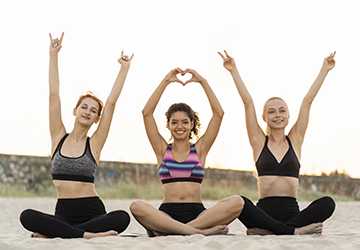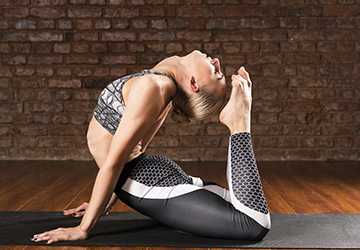Top 3 Yoga Poses for Toning and Weight Loss
Author: Sebastian Walsh
In the quest for achieving holistic well-being and maintaining a healthy lifestyle, the significance of incorporating yoga poses into one's fitness routine cannot be overstated. Besides its spiritual and meditative foundations, yoga has developed into an effective way to shape the body and promote weight loss. In contrast to conventional exercise methods, yoga involves the physical body, mind, and breath, promoting a holistic approach to fitness.

Exploring yoga's role in toning and weight loss, we delve into the multifaceted benefits beyond the physical realm. Incorporating yoga poses into our fitness regimen can be a transformative and sustainable approach to achieving and maintaining a healthy, balanced lifestyle.
Importance of Yoga for Toning and Weight Loss
Yoga involves a series of intentional poses, each designed to enhance strength, flexibility, and balance. When performed with mindfulness and precision, these poses focus on different muscle groups, encouraging the toning and sculpting of the physique. Moreover, the fluid nature of yoga sequences encourages dynamic movement, elevating the heart rate and aiding in burning calories.
Furthermore, the emphasis on mindfulness and breath control in yoga contributes to stress reduction, a factor often linked to weight gain. By fostering a mind-body connection, yoga helps individuals develop a heightened awareness of their bodies, leading to mindful eating habits and increased self-discipline.
Yoga is an adaptable and potent asset to sculpt the body and achieve weight loss. Its distinctive blend of physical postures, controlled breathing, and mindfulness establishes a holistic approach that caters to fitness's physical and mental dimensions. Yoga's flexibility in accommodating various fitness levels ensures that individuals can embrace its benefits at any stage of their wellness journey.
Features of Yoga for Toning and Weight Loss
One of the best features of yoga is its adaptability to diverse fitness levels. Whether you are a beginner or an experienced practitioner, the vast array of poses can be modified to suit individual capabilities. This inclusivity makes yoga an accessible and effective option for those seeking to embark on a weight loss and toning journey.
By engaging in yoga regularly, individuals can enhance muscle tone, flexibility, and balance, leading to a more sculpted and resilient physique. The dynamic nature of yoga sequences also contributes to calorie expenditure, making it an effective tool for weight loss when coupled with mindful eating habits.
Moreover, the stress-reducing qualities of yoga play a pivotal role in weight management. As stress levels decrease, so does the likelihood of engaging in emotional or overeating, fostering healthier relationships with food and promoting sustainable weight loss.
Cobra Pose (Bhujangasana):
Cobra Pose, recognized as "Bhujangasana," is a critical yoga pose designed to increase the strength of the shoulders, back, and abdominal muscles. To perform this pose, lie on your stomach with your legs extended and the tops of your feet pressing into the mat. Position your hands on the ground next to your chest, keeping your elbows close to your body.

Inhale deeply, engage your core muscles and lift your chest off the mat while maintaining a gentle curve in your lower back. Press through your hands to lift your upper body, extending your arms fully. Keep your shoulders relaxed away from your ears and gaze forward or slightly upward.
Cobra Pose strengthens the spine, sculpts back muscles, and promotes improved digestion by stimulating abdominal organs. This energizing pose is known for its ability to open the chest and improve posture, making it a worthwhile inclusion in any yoga routine for those seeking physical strength and flexibility.
Downward Facing Dog (Adho Mukha Svanasana):
Downward Facing Dog, also known as Adho Mukha Svanasana, is a fundamental yoga position well-regarded for its numerous advantages in toning and fortifying different muscle groups. To execute this pose, individuals commence on hands and knees, ensuring that wrists align beneath the shoulders and knees rest beneath the hips. Pushing through the palms, the practitioner lifts the hips toward the ceiling, forming an inverted V shape.

This posture engages the arms, shoulders, and upper back, promoting upper body strength. Simultaneously, the elongation of the spine and stretching of the hamstrings work to improve flexibility and tone the lower body. Downward Facing Dog also encourages the activation of the core muscles, contributing to abdominal toning.
Additionally, this pose facilitates increased blood flow to the brain, enhancing mental clarity and reducing stress. As a versatile pose accessible to practitioners of various levels, Downward Facing Dog is a cornerstone in pursuing overall body toning and well-being within yoga.
Warrior II (Virabhadrasana II):
Warrior II, or Virabhadrasana II, is a dynamic yoga pose with profound significance in toning and strengthening the lower body while promoting balance and concentration. To achieve this pose, start standing, then step one foot back while keeping the front knee bent directly over the ankle. The arms extend parallel to the floor, with shoulders relaxed and facing forward.
Warrior II predominantly focuses on the quadriceps, hamstrings, and inner thighs, promoting strength and endurance in these specific muscle areas. The constant engagement of the arms and the focus on maintaining a robust and grounded stance contribute to toning the upper body and improving posture.
Simultaneously, the pose encourages an open chest, enhancing respiratory capacity. As a pose that demands physical and mental resilience, Warrior II exemplifies the harmonious integration of strength and mindfulness in yoga. It is a valuable addition to any practice geared towards toning and overall well-being.
Conclusion
As we reflect on the transformative potential of yoga, it becomes evident that its impact extends beyond the physical realm. The mind-body connection cultivated through the practice contributes to improved physical fitness and fosters a sense of overall well-being. In embracing yoga as a critical component of our fitness routines, we embark on a healthier, more balanced lifestyle that extends far beyond the mat.
Wonderful Article

Why Gender-Neutral Fashion is Important
The Importance of Gender-Neutral Fashion in the contemporary fashion landscape is more than a trend; it's a significant cultural shift. As society progresses towards greater inclusivity, Gender-Neutral Clothing emerges as a pivotal element in this transformation, illustrating Why Gender-Neutral Matters. This movement transcends the traditional confines of gender in fashion, offering an inclusive, expressive, and liberating approach to personal style.



